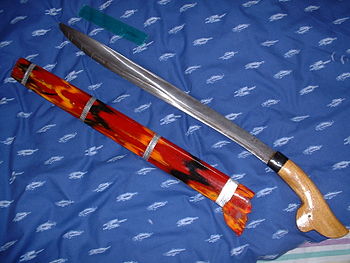Parang (knife)
| Parang | |
|---|---|

A souvenir Indonesian parang
|
|
| Type | Chopper |
| Place of origin | Malay Archipelago region |
| Service history | |
| Used by | Pribumi |
| Specifications | |
| Blade type | Single edge, convex edge |
| Hilt type | Water buffalo horn, wood |
| Scabbard/sheath | Water buffalo horn, wood |
The parang is a type of machete or cleaver used across the Malay archipelago. Typical vegetation in South East Asia is more woody than in South America and the parang is therefore optimized for a stronger chopping action with a heavier blade and a "sweet spot" further forward of the handle; the blade is also beveled more obtusely to prevent it from binding in the cut. This is the same rationale and (in practical terms) the same design as the Indonesian golok and very similar to the Filipino bolo. The parang blade ranges from 10 to 36 inches in length. The parang has a weight of up to 2 lb and the edge usually uses a convex grind. The parang has three different edges: the front is very sharp and used for skinning, the middle is wider and used for chopping, and the back end (near the handle) is very fine and used for carving. A parang handle is normally made out of wood or horn, with a wide end to prevent slips in wet conditions. The tang of the parang is usually of rat tail tang design, and full tang designs are also available.
Like the machete, the parang is frequently used in the jungle as well as being a tool for making housing, furniture, and tools. The parang has been noted in John "Lofty" Wiseman's SAS Survival Handbook for this use.
Parang are recorded being used in attacks against the British and Japanese. They are typically carried as weapons by gang members and robbers in Malaysia, Singapore, India, and Sri Lanka, due to these countries having strict gun laws.
Parangs were used by Chinese forces against the Japanese in the Jesselton Revolt during the Japanese occupation of British Borneo.
Filipino parangs was used by Filipino soldiers under the Philippine Commonwealth Army and Philippine Constabulary including recognized guerrillas against the Japanese during the conflicts against the occupation for the enemy.
...
Wikipedia
